The baroque guitar (A.Schlegel)
The construction of guitars from the 16th to 18th centuries
The strings were grouped in courses, with a course denoting a single string (usually the highest sounding string) or a pair of strings or even a triple string – tuned in unison or at octave intervals. On instruments covered with metal strings (the chitarra battente, whose bent soundboard was probably not introduced until the mid-18th century and the conversion of many older instruments probably only took place after 1750), the strings are usually attached to pins that are inserted through the frame into the lower block behind it. This means that the string tension is not applied to the bridge, as this would lead to severe deformation of the soundboard, but is absorbed by the entire body. The bridge of instruments with this lower string attachment is usually only attached to the top and not glued.
A neck is attached to the body, around which double gut frets are looped at semitone intervals on the guitar. Instruments with metal strings (guitars and citterns) usually have metal frets set into the fingerboard because gut frets would be played through far too quickly. Accordingly, it is possible to draw conclusions about unequal tunings and temperaments on instruments with inlaid frets. However, it should be noted that instruments with gut strings resonate for much less time than instruments with metal strings. It is therefore not surprising that there are no clear iconographic or textual references to unequal fretting for instruments with gut strings from the early 17th century onwards – contrary to the widespread practice of moving frets today.
At the upper end of the neck there is usually a plate to hold the pegs inserted from behind, with which the string tension can be regulated and thus tuned. Machine heads first appeared on the English Guittar (a cister type) in the second half of the 18th century and were transferred to the guitar after 1800. The principle of extended necks (like a theorbo) was also occasionally applied to the guitar.
The guitar types of the 16th century
In the 16th century, the mostly 6-course vihuela was widespread in Spain.
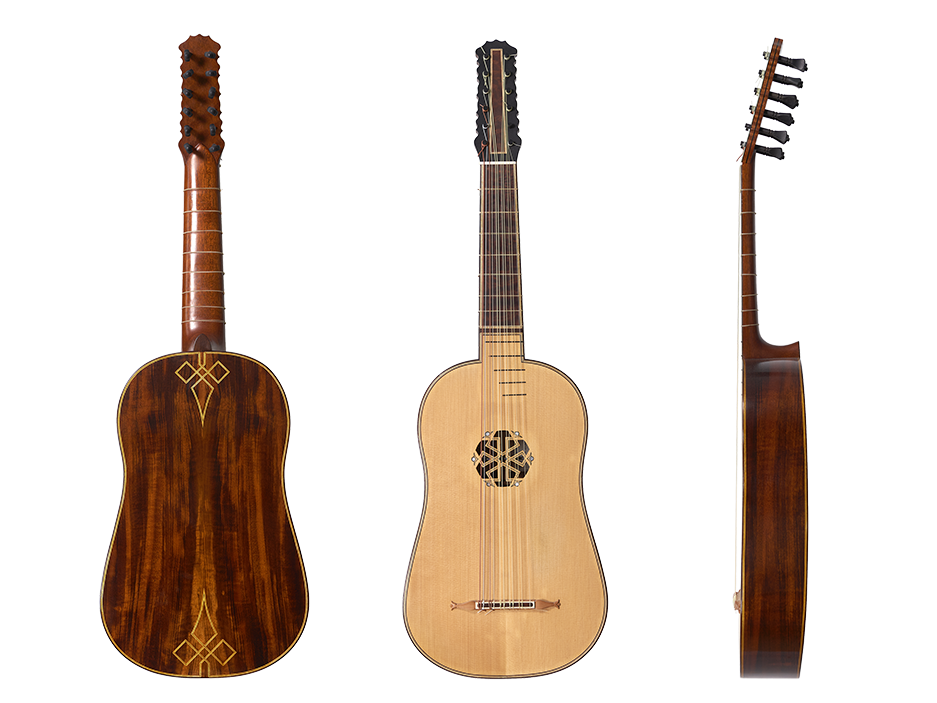
In France and partly in England, a 4-course small guitar instrument was used, which we now call a 'Renaissance guitar' and which had a vibrating string length of approx. 52 cm and was probably tuned in a1-e1e1-c1c1-g1g.

In the last decade of the 16th century, the larger 5-course version with string lengths of up to approx. 75 cm and tuned in e1-hh-gg-d1d-aA (with variants - see below) came into use. Today it is called the baroque guitar. The instruments of the conquistadors also came to the New World.
The early days of the guitar in Italy in the 17th century
The return to antiquity and the 'kythara' as the plucked instrument par excellence before 1600 meant that the 'chitarra' could be an instrument of both the lute and the guitar family around 1600. This is why the guitar form was referred to as 'Chitarra spagnola' - probably for the first time in 1596 in the first edition of Joan Carles Amat's (1572-1642) treatise Guitarra española, which is now lost. This is the earliest known treatise written for the baroque 5-course type. According to Amat, the guitar was normally tuned e1-hh-gg-dd1-Aa, although it is not clear when the octave strings were placed on the thumb side (in contrast to the lute instruments, the vihuela and probably the Renaissance guitar, where the bass string is always mounted on the thumb side and the octave string on the treble side). Amat speaks only of octave strings, but not of their placement.

In Amat's treatise, the 12 major and minor chords are numbered consecutively in the circle of fifths and given the suffix 'n' for 'naturales' (= major) or 'b' for 'mollando' (= minor), starting with E major (= 1n) or E minor (= 1b), followed by A major (2n) or A minor (2b) etc. This indicates an equal-tempered fret setting. Amat emphasizes that only four frets have to be set because all chords can be played within these four frets. Diminished chords and seventh chords are not described. Amat does not go into melody playing at all.
This corresponds to the use of the chitarra spagnola in the early basso continuo period: around 130 Italian prints from the first half of the 17th century give the letters of the alfabeto (see illustration below and the separate section on alfabeto notation further below), so that the chitarra spagnola can be used as an accompanying instrument. This alfabeto notation, which uses a single character per fingering and therefore does not record the major/minor distinction in their symbols, unlike amat, appeared in 1606 with Montesardo and flourished in the 1620s and 30s.
There were also around 65 guitar-only books in which the alphabetic signs were combined with symbols for the striking direction of the strumming hand and rudimentary and therefore often ambiguous metrical indications. Such publications thus disseminate the harmonic schemes of popular improvisation models, combined with strumming instructions. These booklets (often in very small formats, probably intended for the vest pocket) were in fashion until around 1650, whereby the most popular work Vero e facil modo d'imparare a sonare, et accordare da se medesimo la chitarra spagnuola..., published in 1637 by Pietro Millioni and Lodovico Monte (dates of life of both unknown), goes back to earlier prints by Millioni and was published until 1737.
The reduction of harmonic models, which had previously been handed down more or less fully formulated in conventional notation or tablature, to simple fingering sequences and the associated understanding of these models as chord sequences is the significant contribution of the early 17th century guitar played with strumming (rasgueado) to the development towards major/minor tonal harmony. Not coincidentally, it was a guitarist who formulated the rule of the octave in 1716: François Campion (1686-1747).

+ = E minor
A = G major
B = C major
C = D major
D = A minor
E = D minor
F = E major
G = F major
B = B flat major, [...]
O = G minor (whereby all the fingerings that occur in the 'Scala di Musica per b. quadro / b. Molle' are resolved).
The 'scales' for major (b. quadro) and minor (b. Molle) found in many Venetian prints translate into chords:
Major: bass note G = G major, A = A minor, B = G major, c = C major, d = D major, e = E major, f (not f sharp!) = F major, g = G major, a = A minor;
Minor: F = F major, G = G minor, A = A minor, B = B flat major, c = C major, d = D minor, e = E major, f = F major, g = G minor, a = A minor, b = B flat major.
The 'mixed style'
From 1630, Giovanni Paolo Foscarini (dates unknown) began to combine Italian tablature (in which the lowest spatial line corresponds to the highest sounding string and numbers are used for the frets) and alfabeto notation for solo guitar music: the 'mixed style' emerged and was used in 35 prints until the end of the 17th century. After that, the alfabeto signs disappear completely in this style and what remains is the conventional tablature notation with chords written out in tablature, for which 14 prints are known between 1663 and 1720. Alfabeto notation was hardly used outside Italy - despite the textbook by Luis Briçeño, printed in Spanish by Ballard in Paris in 1626, which in turn presents its own alfabeto system. Another system can be found in 1754 and 1774 in the prints by Pablo Minguet e Yroll (dates unknown).
In the French reception of the chitarra spagnola, since the airs with guitar accompaniment in Étienne Moulinié's (1599-1676) third collection of airs de cour from 1629 - also printed by Ballard - the chords have traditionally been written out in French tablature. Even the music by Francesco Corbetta (ca. 1615-1681), which he published in Paris, contains no alfabeto symbols - although his first publication is printed in rasgueado style. With the emergence of the 'mixed style', guitar playing no longer appears as the (quite virtuoso) strumming of whole chords, but as a mixture of melody playing and chord use. This raises the question of tuning once again:
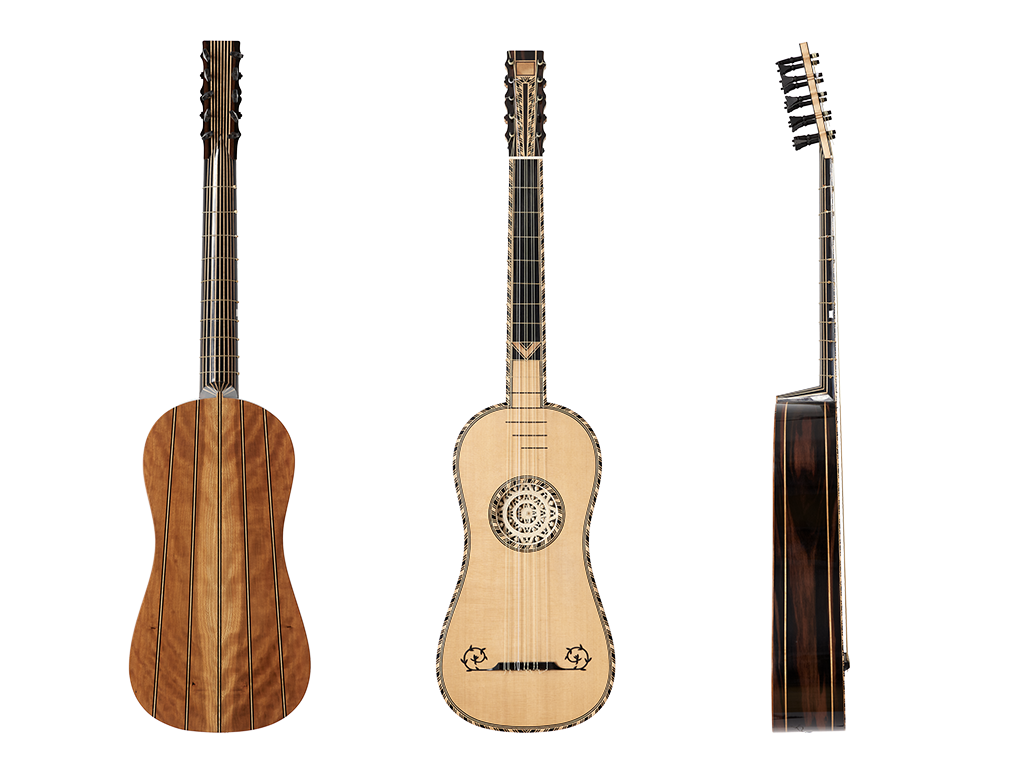
French baroque guitar. Copy after Jacques Bocquay, Paris 1732 (Milano), made by Silvia Zanchi, Bergamo, string length 68.0 cm.
Tunings
The usual guitar tuning - but we also know over thirty scordaturas - comes in three variants, which differ in the octave allocation of the 4th and 5th course:
a) the conventional tuning with the 4th and 5th courses tuned 'normally': e1-hh-gg-dd1-Aa. This tuning is the basis for most books in rasgueado style and is often used when the guitar plays 'normal' basso continuo.
b) the 'semi-reentrant tuning' with the high octave 5th course: e1-hh-gg-dd1-aa. This is the normal tuning
c) re-entrant tuning with the two high-octave courses 4 and 5: e1-hh-gg-d1d1-aa
Today it is often claimed that the 3rd course was equipped with an octave string. This is feasible in the age of nylon strings (and thus proven by ""historical"" recordings), but simply unthinkable against the background of the orientation of the instrument size according to the breaking point of the string material, which was the norm for plucked instruments until the 18th century: After all, the octave string would be a g' - i.e. a minor third higher than the string to which the break point and thus the string length refers. You should also read the articles by Lex Eisenhardt and Monica Hall (see literature), which suggest that this is a misinterpretation of two treatises.Not every guitar book contains tuning information. And in many sources the tuning indications are ambiguous.
Why is this tuning issue so important?
Regardless of the tuning used, there are phenomena in music for baroque guitar that sound unacceptable to today's ears, but were not condemned anywhere in the 17th century:
- If all strings are strummed, chords can be created in which the fifth of the chord is the lowest note, resulting in a six-fourth chord that usually sounds as an independent chord rather than an appoggiatura.
- Octave strings can cause octave doublings of the melodic line. This is particularly audible when scales are played over several choruses using the campanella technique. (More on this technique below.)
- Baroque guitar literature sometimes contains seventh or ninth jumps in melody lines - regardless of the tuning used. This is illustrated in the following example from a pavana by Gaspar Sanz in Italian tablature, in which the lowest spatial line corresponds to the highest-sounding chorus and numbers indicate the frets:
There is no tuning in which all seventh or ninth jumps (which are marked with the star or 7 respectively) can be avoided. But there is only one best solution: tuning c).
This example also shows the Campanela technique, in which the notes of a scale are not played on one string but on several. Where possible, the thumb strikes the stronger time signature. This technique is obvious on instruments with re-entrant tunings and tunings that predominantly have third intervals: we find it in guitar, theorbo, cittern and baroque lute music.

(Robert de Visée, Livre de guittarre, Paris 1682, p. 4: 'Je prie ceux qui scaurons bien la composition, et qui ne connaistreront pas la Guittare, de n'estre point scandalizez, s'ils trouent que ie m'escarte quelque fois des regles, c'est l'Instrument qui le veut.')
The guitar in the 18th century
As already mentioned above, from the middle of the 18th century onwards, the bending of the soundboard in combination with metal strings was introduced - first for mandolin types and shortly afterwards for guitars. This type of guitar with metal strings, a bent soundboard and a freely attached (and not glued) bridge is called a chitarra battente. Many older guitars were rebuilt. To the best of our knowledge, this conversion has never been documented by means of a repair note, so that the instruments converted in this way are either completely anonymous or only bear the label of the original maker and it was therefore concluded until recently that these instruments were originally equipped with the bent soundboard. As a result, the method of bending and the type of chitarra battente were dated far too early. In the meantime, many criteria are known which can be used to prove a conversion, and so far no guitar is known to have a bent top that was bent before around 1750. On the contrary: every detailed examination with the current state of knowledge has been able to identify traces of subsequent rebuilding. However, it will be some time before this new knowledge is established.
A "standard type" is the 14-string chitarra battente with the following string arrangement:
1st chorus e' e'
2nd chorus h h h
3rd chorus g g g
4th chorus d' d' d
5th chorus a a A
Whether the 4th and 5th courses were equipped with a bass string or only with high octaves has not yet been conclusively clarified from sources for the period from around 1750 to 1830.
The chitarra battente is still a folk music instrument used in Italy today. While it is mainly played in southern Italy today, it used to be widespread as far north as Italy.

The 5-course guitar with the tuning b) ('semi-reentrant tuning') was used until the middle of the century. Gradually, however, playing the bass line became more important, so that the tuning was changed to e1-hh-gg-d1d-aA (with the basses on the thumb side), thus opening up the possibility of using single strings: e1-h-g-d-A.
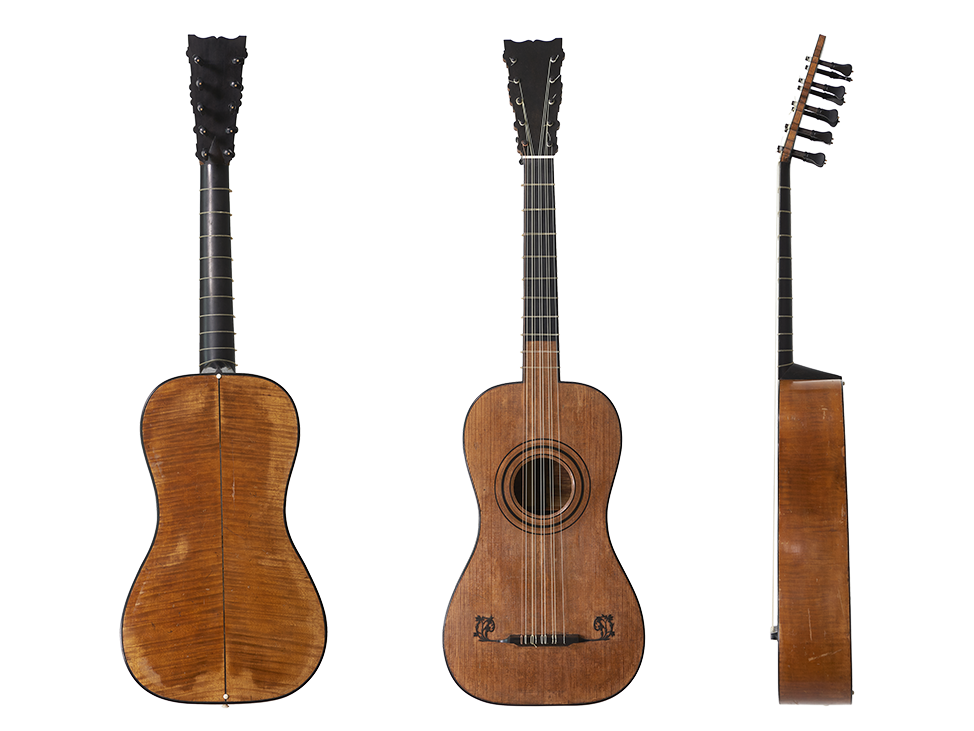
This development towards the 5-string guitar and the shortening of baroque guitars with a scale length of over 64 cm to 64 cm or less seems to have been prompted by the emergence of a new sound aesthetic:
From around 1730 mandoras - a type of lute that was tuned in e1 and whose tuning corresponded to that of the guitar, whereas it normally comprised 6 courses - were built either at the breaking point or far from it, with string lengths of around 60-63 cm. These string lengths are far below the breaking point of the string material, so that much thicker strings than Chanterelle could be used. This in turn led to a much more fundamental sound. At the same time (from around 1730), silk strings wound with metal wire seem to have begun their triumphant advance.
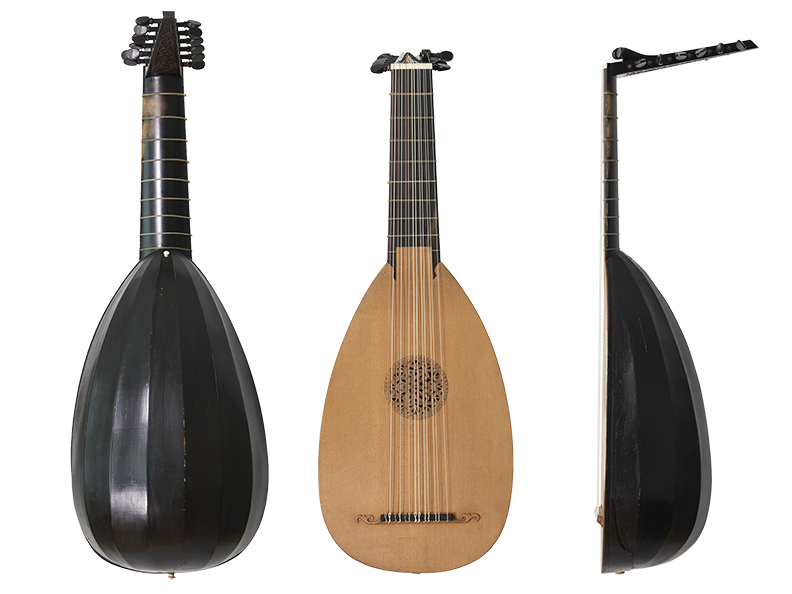
The mandora with its stringing with octave strings allowed a range of 2 octaves and a fourth (with the same scale length). The lyre-guitare, invented shortly before 1780 with a string length of approx. 58-61 cm, was the first 6-stringed instrument in the tuning e1-h-g-d-A-E, today's guitar tuning. Apparently the new wound strings allowed this range, even if the diameter of the chanterelle was now considerably thicker and probably corresponded to the diameter of the former 2nd course.

Around 1760, Giacomo Merchi introduced conventional notation instead of tablature in his Opus 3 for guitar - even though both forms of notation existed side by side for decades. In French guitar and mandora literature from the 1770s onwards, which was published in conventional notation, there are many passages with smaller engraved basses for the mandora and normal-sized notes for the 5-string (or 5-course) guitar. Here is an example from J.S. Felix: Recueil d'airs et ariettes choisies avec accompagnement de guitarre ou mandore [...] oeuvre 2.e., Paris ca. 1770, p. 19. Digital version: https://gallica.bnf.fr/ark:/12148/btv1b90789744 (17.10.2019):
The move away from tablature was encouraged by the simultaneous existence of a wide variety of plucked instruments from the lute, guitar and cister family with different tunings: Tablature would have referred to a specific tuning and therefore to a specific type of instrument, whereas with conventional notation the adaptation to the instrument currently being played was left to the musician.
The 6-string concept of the lyre-guitare was later adopted for the guitar.
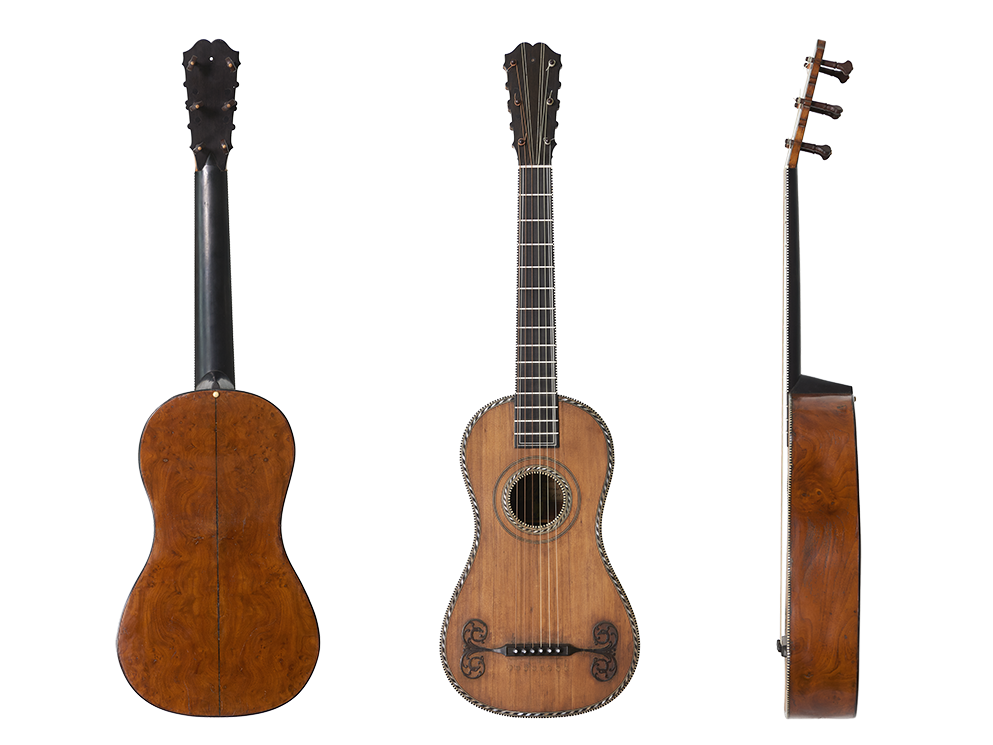
When and where the first 6-string guitars were made is debatable: 5-string or 5-course instruments were converted to 6-string instruments - and these conversions often cannot be dated exactly or it is often not clear whether the current 6-string state is original or was only achieved through a conversion. The 6-string guitar was often referred to as a "chitarra francese" around 1800. On the other hand, some 6-string guitars are known, particularly from Naples, which were probably made as 6-string instruments before the turn of the century (e.g. an instrument with the label "Joseph. Filano Donati filius fecit Neap. || Alla Rua di S. Chiara Anno 17 [ms.] 93"). It is certain that Paris became the center of the 6-string guitar early on, before this type was established in the German-speaking and English regions.
The alfabeto - an introduction
When we look at old musical notation systems such as the alfabeto from today's perspective, we must first realize what we take for granted in today's notation.
Today it is clear that the frequency of 440 Hz is assigned to a1 and that the instruments are in principle all tuned to 440 Hz (orchestral instruments possibly a few hertz higher).
This standardization of the tuning pitch was only adopted in 1939 as the ISO 19 standard at the last international tuning pitch conference in London. Prior to this, different pitches were used: On the one hand, there were regional differences, for which Giovanni Battista Doni may be quoted, who wrote in 1640 that the pitch in Italy dropped by a semitone from region to region, namely from Venice (with a1 = 460-470 Hz) via Lombardy (a1 = 440 Hz) to Tuscany (a1 = 415 Hz), to Rome (a1 = 392 Hz) and Naples (a1 = 370 Hz). On the other hand, even within the same city, pitches were derived from the respective organs - and if there were several organs, they were rarely on the same pitch. Such an organ tuning pitch was then subdivided by transposition into a high Chorton and a Kammerton (usually a whole tone lower).
If we think in the categories of earlier times, the priority for setting the tuning pitch for stringed instruments is completely different:
- Physics (e.g. the breaking point of string material)
- Sound aesthetics (e.g. adaptation to the natural resonances of the sound body; sharpness or timbre as a criterion for continuo or solo instruments)
This means that the string length of the highest sounding string determines the maximum achievable frequency, the sound aesthetics determine the working range or, in other words, the effective frequency of this string - and not a tuning pitch.
If you play together with other instruments, you adjust the tuning tone to the instrument that is the least flexible.
Today, the guitar is normally built to an e1 at a tuning pitch of a1 = 440 Hz with a string length of 65 cm. This strng length is very far outside the breaking point of gut, which would be 75.8 cm - or 71.5 with a half tone distance to the breaking point. And if you take fluorocarbon or nylon, the string length could be even greater (up to 77 cm), because the breaking point for these materials is 270 Hz / m or 262 Hz / m respectively.
It is therefore clear for these older times that the size of the instrument and the sound aesthetics determine the effective frequency. And plucked instruments were built in different sizes. Tablature as a notation concept does not indicate frequencies (like today's notation) or note names (as in the days of different tuning pitches), but rather fingering positions on the fingerboard or empty strings. This means that the same piece played on a larger instrument automatically sounds lower and correspondingly higher on a smaller instrument. The fingering positions do not change - only the frequency is lower or higher depending on the size of the instrument.
This tablature principle is now logically applied to fingerings for the baroque guitar: With the Alfabeto, fingering patterns are provided with recognizable letters or symbols - regardless of the sounding result in Hertz or note names.
This becomes even more understandable for another reason: terms such as "E minor" or "C major" did not even exist around 1600. This type of chord designation was only slowly developed in the second half of the 18th century - when the alfabeto had disappeared again, with a few exceptions.So when we, as today's guitar players, look at the alfabeto notation without reflection, we assume three conditions that did not exist at the time:
- Standardized tuning pitch: The guitar is in e1 - naturally in the pitch of a1 = 440 Hz.
- Strings can be pulled up almost at will: The experience of the breaking point is simply no longer present.
- Chord names already existed at that time.
With the incorporation of previously unwritten folk music into written art music around 1600, chordal accompaniment on the 5-course guitar - for which the alfabeto was the recording method of choice - was also written down.
Because the fingering and not the pitch is notated, it is a relative notation: the size of the instrument determines the frequencies of the fingered notes and the local tuning pitch determines the nominal pitch designation: the vibrating string length of 76 cm results in an achievable frequency of 311 Hz with gut strings if the string is tuned just below its breaking point. With a modern tuning pitch of a1=440 Hz, this frequency corresponds to an e flat1. If the tuning pitch is 415 Hz (a semitone lower), the same frequency results in an e1.
If the same piece is played from Alfabeto on a smaller guitar, it sounds higher than if it is played on a larger instrument. This is what is meant by the term "relative notation". Significantly, there is an Alfabeto print from 1627 which contains quartets for four differently tuned guitars. The highest strings of the instruments are nominally tuned to a1 (soprano), f#1 (contralto), e1 (tenor) and d1 (basso).
For the sake of simplicity, however, in the following illustration I assign the fingering patterns to a guitar whose highest string is tuned to e1 (like today's guitar; in the Italian tablature the highest sounding string is notated spatially at the bottom). However, relative thinking must be kept in mind as a basic condition.
Juan Carlos Amat probably introduced a kind of alfabeto in 1596. Unfortunately, this print has not survived. The earliest surviving print containing an alfabeto was published by Girolamo Montesardo in Florence in 1606. His alfabeto comprises 27 fingerings and contains all the letters commonly used in Italy at the time (i.e. no J, U and W) as well as special characters +, &, Con (looks similar to 9) and Ron (an R with a stroke through the stroke to the right, so that this part of the letter looks like an x).
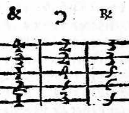
Contemporary music theory did not think in terms of chords and therefore did not have a key system. Accordingly, Montesardo's alfabeto does not contain a structure that seems logical to us with today's harmonic thinking.
His alfabeto begins with the sign + and then goes through the alphabet.
First there are fingerings up to and including the letter F, which can be played without a barré.
G is then the E major fingering shifted to the 1st fret (sounding in F major) and H is the A major fingering shifted to the 1st fret (sounding in B flat major), before the A major fingering itself appears at the letter I (without barré). The G minor fingering is letter O. So from letter G onwards, everything is barré fingering (with the exception of I and O).
From letter Q onwards, the fingerings are shifted to the 2nd or 3rd fret - again, not systematically, but mixed. The letter & is the C major fingering shifted to the 1st fret (sounding D flat) and thus the disturbing exception.
A barré fingering can of course be shifted over the 2nd or 3rd fret. This is why Giovanni Colonna notated such shifted fingerings as early as 1620 as alphabeto signs, but supplemented with the number of frets by which the fingering is shifted.
The D major fingering played without a barré is called C, the D major fingering shifted to the 1st fret is called M.
The D major fingering shifted to the 2nd fret is actually called S, but now also M2; at the 3rd fret it is actually Ron, but now also M3.
Normally, therefore, a fingering shifted to the 1st fret is chosen as the starting point. However, if the shifted fingering is originally fingered at the 2nd fret (e.g. R = 24442), R2 can mean "Barré at the next higher fret", i.e. 35553, R3 46664 etc. - depending on the source, however, the position of the barré could also be indicated.
The fingerings E, A, D, G and C major as well as E, A, D, G and C minor are shifted.
The reduction to the 10 movable fingerings opens up the system. Pietro Millioni omitted the letters from Q onwards in 1627. Most authors, however, leave a large part of the original alphabet and at the same time use the combined representation, so that, for example, the characters G3 and Y are used (see example: G3=Y, M3=Ron). This means that the same fingering can have several fingering designations in the period from ca. 1632 to ca. 1661 - there are multiple designations for the same fingering (see table below).
The Trattenimento virtuoso by Giovanni Sfondrino, printed in Milan in 1637, has the most multiple designations, namely ten:
E2=Con,
G2=Q,
G3=Y,
H2=R,
H3=Z,
K2=X,
M2=S,
M3=Ron,
N2=T,
P2=V.

Of particular interest is the fingering L from the original alfabeto, which reads 33013 when expressed in tablature letters. The numbers correspond to the frets of the highest to lowest course; in this case, assuming tuning e' h g d A, this would result in the notes g' d' g e flat c. The major ninth c-d' does not always sound good, of course. Occasionally you can also find the tablature markings for 34013, whereby the d' becomes an e flat'. However, this is not so easy to finger on larger instruments. Has the d' been notated but only muted by skillfully placing the finger loosely instead of making the wrong note sound?
As an additional extension, unusual fingerings with dissonances (e.g. ninths) or with special fingerings in higher registers are also notated from 1623 onwards and provided with compound special signs. So far I have found 53 signs outside the original alfabeto, whereby I have not counted small variants such as lower case instead of upper case separately. Because several different characters were used for many fingerings, there are therefore more characters than there are fingerings.
This makes it clear that a large number of signs and designation systems existed and consequently the guitar prints normally contain a table of the signs used in the book. In Kapsberger's first book of villanelles from 1610 in copperplate engraving, which is designed for 1-3 voices, theorbo (with continuo written out in tablature) and guitar, knowledge of the alfabeto is assumed; in the second book in type print, a table is added - but with many deviations from Montesardo's alfabeto: + is missing; B is the variant 31023 instead of 01023; L [C minor] is 34553 instead of 33013 / 34013 [see above]; S is 22244 instead of 45422 and thus a different fingering; T 23442 instead of 52224; V 52224 instead of 22244; X 00022, which corresponds to +, instead of 23442; Y 45422 instead of 33455 and Z 56533 instead of 35553. This clearly shows how much the Alfabeto was in flux.
Two tables are provided here to illustrate the alfabeto systematics, whereby an instrument in e1 is assumed for the reinterpretation of the fingering type in modern chord designations.
The first table is structured according to the circle of fifths (with directly added minor parallels):
| Alfabeto systematics | V = fingering variant | italic = Potential multiple designation | ||||||||
| Fingering type, thought in e1 | high – low | empty |
0 V. | I | II | II V. | III | III V. | IV | V |
| E | 00122 | F | G | Q | Y | g | ||||
| A | 02220 | I | H | R | Z | h | Et | |||
| D | 23200 | C | C5 | M | S | Ron | m | b' | ||
| G | 33002 | A | N | T | n | |||||
| Em | 00022 | + / B9 | P | V | p | |||||
| C | 01023 | B | Bt | & | ||||||
| Am | 01220 | D | K | X | k | |||||
| Dm | 13200 | E | M+ | Con | ||||||
| Gm | 33001 | O | ||||||||
| Cm | 33013 [!] / 34013 | L | l | |||||||
The second table is arranged according to the fingering names, with those barré fingerings which are listed in the alfabeto before the last fingerings without barré being shown in bold:
| Fingering type, thought in e1 | high – low | empty | I V. | I | II | II V. | III | III V. | IV | V |
| Em | 00022 | + / B9 | P | V | p | |||||
| G | 33002 | A | N | T | n | |||||
| C | 01023 | B | Bt | & | ||||||
| D | 23200 | C | C5 | M | S | Ron | m | b' | ||
| Am | 01220 | D | K | X | k | |||||
| Dm | 13200 | E | M+ | Con | ||||||
| E | 00122 | F | G | Q | Y | g | ||||
| A | 02220 | I | H | R | Z | h | Et | |||
| Cm | 33013 [!] / 34013 | L | l | |||||||
| Gm | 33001 | O | ||||||||
The mentioned multiple designations for the same fingering pattern in two representations:
| multiple designations | ||||||
| Griff-Typ Bd. | Alf. Bd. | Symbol | Symbol | Alf. Bd. | Griff-Typ Bd. | |
| Dm I | E1 | M+ | M+ | E1 | Dm I | |
| Dm II | E2 | Con | Q | G2 | E II | |
| R | H2 | A II | ||||
| E II | G2 | Q | S | M2 | D II | |
| E III | G3 | Y | T | N2 | G II | |
| V | P2 | Em II | ||||
| A II | H2 | R | X | K2 | Am II | |
| A III | H3 | Z | Y | G3 | E III | |
| Z | H3 | A III | ||||
| Am II | K2 | X | Con | E2 | Dm II | |
| Ron | M3 | D III | ||||
| D II | M2 | S | ||||
| D III | M3 | Ron | ||||
| G II | N2 | T | ||||
| Em II | P2 | V | ||||
Another aspect is the placing / temperament of the frets. Modern lutenists tend to use meantone fretting on the baroque guitar as well. This contrasts with the practice recorded in the alfabeto prints: Montesardo's print from 1606 already uses 11 major keys and 8 minor keys. All 12 major keys are used by Colonna in 1620 (and 9 minor keys). Millioni publishes 1635 pieces in all 12 major and minor keys. It is therefore clear that only an equal-tempered fret setting (probably according to the 18-note division) can fulfill these requirements - since 1606.
The previous evaluation was based on Gary Boye's information on the 53 prints described on his homepage for the Rasgueado sources: http://applications.library.appstate.edu/music/guitar/strummed.html
You can download my data collection here.
It will be a long-term task to record all the other sources with alfabeto notation accordingly. In my database, I have recorded as many as 181 prints from 1594 (unfortunately lost) to 1780 with alphabeto notation, the majority of which use the alfabeto as notation for the accompaniment of songs.
It is obvious that chordal thinking was introduced into writing around 1600, probably from a practice that had already existed for some time. Music theory did not reflect this practice, which was purely chordal (regardless of the chord position) and not based on the bass line, until Rameau formulated the idea of the "basse fondamentale" in 1722. Around 1710, the chord names used today (A minor, B flat major etc.) entered the German-speaking world (e.g. in Mattheson, who refers to Italian musicians) and by the end of the 18th century they had become established.
Literature
• J.C. Amat, Guitarra española, s.l. (all editions published in Catalonia and Spain) 1596 [lost], further editions 1626, 1627, revised 1639, 1640, 1671, 1674; with additional treatise Tractat breu: s.d. [1703–13], s.d. [1735–1787], 1745, 1758, 1761, 1768, 1780; facs., eb. by Monica Hall, Monaco 1980
• G. Montesardo, Nuova inventione d‘intavolatura, per sonare li balletti sopra la chitarra spagniuola, Firenze 1606
• G. Boye, Bibliography on sources in Rasgueado style with soloistic literature: http://applications.library.appstate.edu/music/guitar/strummed.html (30.1.2018)
• G. Boye, Bibliography on sources in 'mixed style': http://applications.library.appstate.edu/music/guitar/mixed.html (30.1.2018)
• M. Praetorius, Syntagma Musicum. Tomus Secundus De Organographia, Wolfenbüttel 1619; facs., ed. by W. Gurlitt, Kassel etc. 1958
• M. Mersenne, Harmonie Universelle. Livre Troisiesme des Instruments à chordes, Paris 1636/37; facs., Geneva 1973
• F. Campion, Traité d’accompagnement et de composition, selon la règle des octaves de musique, Paris 1716; facs., Geneva 1976
• L. Briceño, Metodo mui facilissimo para aprender a tañer la guitarra a lo Español., Paris 1626; facs., Geneva 1972
• G. Sanz, Instrucción de música sobre la guitarra española, Zaragoza I: 1674, II: 1675, III: s.d.; facs. (books I–III), Geneva 1976
• P. Minguet e Yroll, Reglas y advertencias generales que enseñan el modo de tañer todos los instrumentos mejores, y mas usuales, como son la guitarra, tiple, vandola, cythara, clavicordio, organo, harpa, psalterio, bandurria, violin, flauta traversera, flauta dulce, y la flautilla, Madrid 1754; facs., Geneva 1981
• R. de Visée, Livre de guittarre, Paris 1682 & Livre de pièces pour la guittarre, Paris 1686; facs., Geneva 1973
• J. Tyler / P. Sparks, The Guitar and its Music from the Renaissance to the Classical Era, Oxford 2002
• M. Lustig (ed.), Gitarre und Zister. Bauweise, Spieltechnik und Geschichte bis 1800 (22. Musikinstrumentenbau-Symposium Michaelstein, 16. bis 18. November 2001), Dößel 2004
• J. Tyler, A Guide to Playing the Baroque Guitar, Bloomington & Indianapolis 2011
• L. Eisenhardt, Italian Guitar Music of the Seventeenth Century: Battuto and Pizzicato, Rochester 2015
• M. Hall, Baroque Guitar Research, https://monicahall.co.uk (30.1.2018)
• L. Eisenhardt, http://lexeisenhardt.com (30.1.2018)
• G. Rebours, http://g.rebours.free.fr (30.1.2018)

